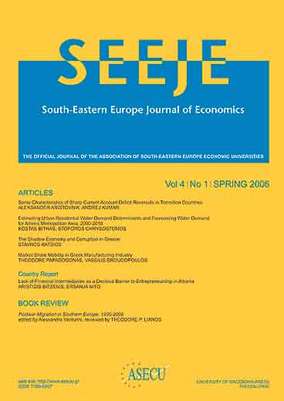Evaluation of the impact of business on the environment using green accounting indexes and modern statistical methods
Part of : SEEJE ; Vol.11, No.1, 2013, pages 49-58
Issue:
Pages:
49-58
Author:
Abstract:
To date, accounting and financial sciences have attempted to assess companies using financial ratios and other techniques that evaluate only the front office, without considering its impact on the environment. Recently, this assessment has been expanded to include new concepts, known as corporate social responsibility and social balance. These new concepts are usually viewed and studied using a multidisciplinary perspective with an aim to update the current and future value of the company. In this evolving scientific field a considerable effort has been made to objectively record and calculate the environmental impact of a company’s activities by integrating these elements into a new form of economic balance sheet. The present paper seeks to examine the presence of weighted environmental indexes and explores the process by which they can be used to evaluate a company.
Subject (LC):
Keywords:
econophysics, enviromental indexes, neural networks
Notes:
Περιέχει διαγράμματα και βιβλιογραφία, JEL Classification: Q5-Environmental Economics, Q51-Valuation of EnvironmentalEffects
References (1):
- Αδαμίδης (Adamidis), Α. (1998). Ανάλυση Χρηματοοικονομικών Καταστάσεων (FinancialStatement Analysis). Αθήνα: University Studio Press.Βενιέρης (Venieris), Γ.(2007). Διοικητική Λογιστική (Managerial Accounting). Αθήνα: Π. Ιωαννίδου& Σια Ο.ΕΔιαμαντάρας (Diamantaras), Κ. (2007). Τεχνητά Νευρωνικά Δίκτυα (Artificial Neural Networks).Αθήνα: Κλειδάριθμος.Ζαπράνης (Zapranis), Α. (2005). Χρηματοοικονομική και Νευρωνικά Συστήματα (Finance andNeural Systems). Αθήνα: Κλειδάριθμος.Cybenko, G.V. (1989). Approximation by superpositions of a sigmoidal function. Mathematics ofControl, Signals and Systems, 2, 303-314.AccountAbilityDeloitte Touche TohmatsuFunahashi, K. (1989). On the approximate realization of continuous mappings by neural networks.Neural Networks, 2, 183–192.Garrison, Ray H., Noreen, E., Brewer P. C. (2009). Managerial Accounting. UK: McGrawHill.Global Reporting Initiative (GRI)Hartmann, E.J., Keeler, J.D., Kowalski, J.M. Layered (1990). Neural networks with gaussianhidden units as universal approximators. Neural Computation, 2 210-215.Hebb, D. (1949). The organization of behaviour. UK: John Wiley.Horngren, C.T. &Olivar, S. (2009). Managerial Accounting. UK: Prentice Hall.Hornik, K Stinchcombe M & White, H. (1989). Multilayer Feedforward Networks are UniversalApproximators. Neural Networks, 2, 359-366.ISO – Sustainability ReportingKaplan, R.,S Atkinson, A., Young, S. (2003). Management Accounting. UK: Prentice Hall.McCulloch, W.S., & Pitts, W. (1943). A logical calculus of the ideas immanent in neurons activity.Bulletin of Mathematics and Biophysiology, 15, 115-133.




